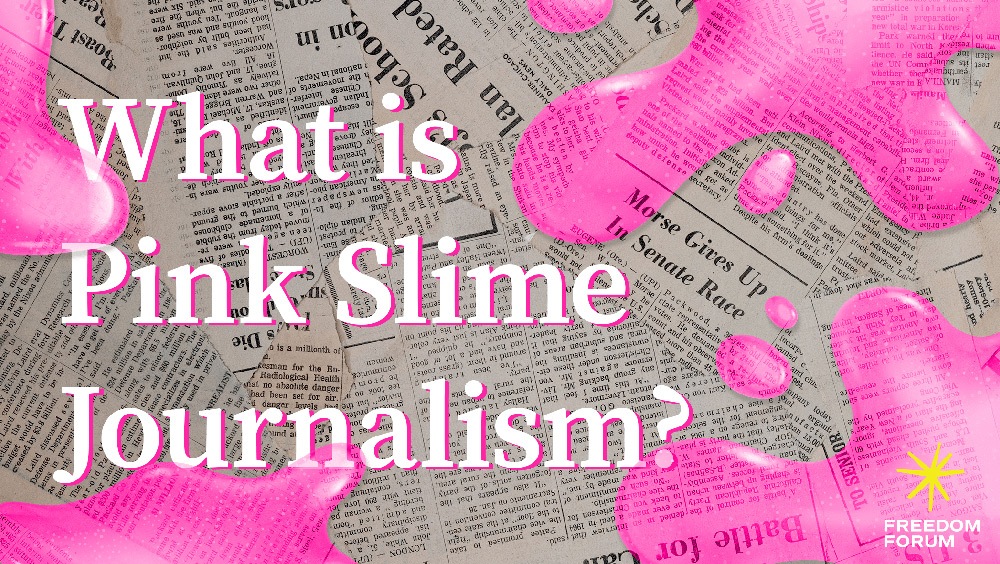Pink Slime Journalism: Separating Ethical News From Propaganda

Pink slime may sound like a gimmick on a Nickelodeon game show. And watching people get “slimed” for laughs is fun (though on Nickelodeon, it’s green). But dropping bad information into people’s mailboxes and internet search results is not.
"Pink slime journalism" is just that: Bad information meant to make people think it’s wholesome and nutritious when, in reality, it’s empty calories.
What is 'pink slime journalism'?
The term “pink slime” comes from a food industry phrase for a meat product that’s used as a filler in ground beef, like a cosmetic injection to make your lips look bigger and fuller.
Pink slime is not a new phenomenon or phrase in journalism. In 2012, the public radio program and podcast “This American Life” detailed efforts by a company called Journatic that was producing pink slime – and selling it to major news outlets. Journatic rebranded itself as Locality Labs after the report.
A 2019 Columbia Journalism Review report found more than 450 pink slime websites in the U.S. By 2020, the number was more than 1,200. Most of the sites operated as part of a network owned by larger conglomerates such as Metric Media, largely with the goals of influencing politics.
In the context of news and information, pink slime is a product that poses as the real thing but lacks real substance or context.
In practice, that could look like:
- Buying the physical assets and web domain of a news outlet that’s shutting down (made-up example: EverytownDailyNews.com) and populating it with AI content that is not actual news but aggregates information from other websites, including social media. It likely lacks context and actual reporting. Sometimes the content on the website will be nonsensical or garbled, a common indicator of AI-produced writing.
- Creating a new website that sounds like an existing news outlet (made-up example: TallahasseeExpressNews.com) but exists solely to put out political attack ads and similar partisan content funded by political operatives.
- Making a new printed publication that looks and feels like a newspaper with a “newsy” name (made-up example: The Heartland Times-Chronicle) and paying to have it mailed to every address in a city or county. Often the “news” will be thinly veiled political ads or other forms of content meant to influence people to vote a certain way or support or oppose an issue of public concern.
Pink slime is similar to but separate from cybersquatting or domain squatting.
That’s more narrowly defined as buying an available domain name (example: pinkslimejournalism.com) and sitting on it in order to attract interested buyers who want the domain name themselves. It can also be registering a web domain that is similar to an existing brand with the aim of profiting from the brand by confusing people. Sometimes the owner of an existing web domain will forget to renew their ownership, and a fast-thinking person will buy the rights to the domain. Then the new owner will “squat” on the website domain until the previous owner is willing to pay a high price to get it back.
In this way:
- Cybersquatting and domain squatting are making money from buying and selling in-demand website domains or confusing people with a website similar to an existing well-known brand.
- "Pink slime journalism" is buying out-of-business newspaper brands or news websites or creating new names that sound “newsy” and distributing them in print or digital form with poorly constructed information, sometimes for a political purpose. Making money can be a goal but not always.
Does the First Amendment protect 'pink slime journalism' and publications?
The First Amendment prevents the government from restricting speech. It also means the government can’t tell news outlets what to publish or prevent them from publishing things that aren’t approved in advance.
Though there are some exceptions to these limitations on government, generally speaking the First Amendment would protect pink slime websites and publications. Simply put: Bad information isn’t automatically illegal information.
Here are some specific examples of content on pink slime websites that may or may not be protected by the First Amendment:
Protected
- Political speech. This kind of speech receives the highest level of First Amendment protection. Even if something is pretending to be a legitimate news outlet while advancing a partisan message for a candidate or political action committee, it is protected speech.
- Satire or parody. Even though satire and parody are generally made-up and untrue (example: The Onion or Babylon Bee), they are forms of expressive speech, just like stand-up and other forms of comedy are protected speech.
- Publishing without a license. Under the First Amendment, there is no requirement that journalists or news outlets have a government-approved license to do their jobs or to publish online or in print. In this way, anyone can be a journalist, and anyone can publish a website that appears to be a legitimate news outlet because there is no legal proof or test required to practice (unlike doctors, lawyers and other professional occupations).
Not protected
- Obscenity. What qualifies as obscene speech or other forms of expression is narrowly defined by the courts.
- Defamation and libel. There is a difference between satire and parody and defamation and libel. Asserting facts that you know are false, causing real harm to someone’s reputation, and acting negligently (if you are writing about a private figure) or with “reckless disregard for the truth”(if you are writing about a public official or public figure) can mean someone producing pink slime is not protected by the First Amendment. This same standard applies to all journalists and news outlets – and to non-journalists, too.
- Copyright or trademark infringement. Stealing someone else’s work and portraying it as your own is not protected by the First Amendment. Neither is making your website or publication look like an existing news brand by stealing another organization’s existing name and logo and pretending to be them to confuse people.
- Commercial speech. This is used to sell a service or product, and some forms of pink slime are just advertising meant to make money. Not all commercial speech is automatically protected by the First Amendment in the same way political speech is. It’s possible that pink slime could have less free speech protection if its aim isn’t political but is strictly commercial. Attempting to mislead people for commercial purposes can be legally punished.
Tips to identify 'pink slime journalism' and separate it from standards-based journalism
Distinguishing between pink slime and “real” news can be hard, and not only because they might look similar on websites and in print.
Since there is no journalism “license” to check, it’s often up to individuals to sort through all the information they’re getting and determine what is healthy food and what is unhealthy filler.
As journalist David Cohn says: "Journalism is a process, not a product."
With that in mind, here are tips to consider whether the information you see online and in your mailbox is coming from a standards-based news outlet or one that traffics in pink slime. These are drawn from media literacy techniques used by educators to teach fact-checking and verification, using the letters E.S.C.A.P.E. – so you can escape junk news.
- Evidence. Do the facts of what’s being said hold up? What information is provided (documents, names, dates, etc.) that you can verify from a separate, outside source?
- Source. Who is behind this publication? Is there an "about" section with contact information? Is there a phone number or just a generic email? Is there an author? Can you find staff elsewhere on social media or with other bylines? Are staff pictures available? Do those pictures look like real humans or AI-generated? (Some real news outlets have been caught with fake writers.)
- Context. Is there information beyond what happened and when? Does it look like a person compiled the information by being in a location with other people and talking to them? Is there anything not in the story that you think should be if it were written by a real person with knowledge of the subject?
- Audience. Is this being written for a particular person or kind of person? What kind of language or images are used that may appeal to a certain political, ideological or cultural belief?
- Purpose. Ask why this was made and what the motivation may be of the person or group behind it. Does it feel like the only motivation is to make money without giving people reliable information? Are there obvious political goals? What might be the agenda of the person or group behind it, whether obvious or subtle?
- Execution. How is the information presented? Does it look professionally produced and edited or sloppy and filled with errors?
There are many other tips for separating good and bad information or ways of spotting and pushing back on "fake" and flawed news. A popular way of verifying online information, including from pink slime publications, is the SIFT method from University of Washington information researcher Mike Caulfield. The News Literacy Project has lots of resources for the public, educators and students for separating good information from noise.
These are not perfect ways of separating pink slime from standards-based news. Even standards-based news outlets make errors on occasion. Many news outlets are for-profit, and all need income to stay afloat. Journalists have been caught lying, plagiarizing or making up stories. Those who do so while working for standards-based news outlets are fired or otherwise punished.
What’s vital to check is how news outlets respond to such errors and ethical lapses. As the Code of Ethics of the Society of Professional Journalists says: “Journalists should … Abide by the same high standards they expect of others.”
More importantly, the First Amendment means such journalism ethics codes are not legally enforceable. That means the public is a key player in identifying, checking, and calling out bad news and information, whether or not it’s dripping with pink slime.
Scott A. Leadingham is a Freedom Forum staff writer. Email
Recording in Public: Is It Illegal to Record Without Permission?
Is It Illegal to Impersonate Someone? A First Amendment Analysis
Related Content

